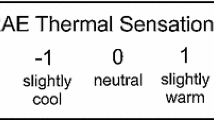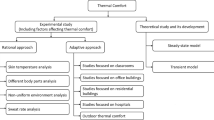Abstract
International Standard ISO 7730:2005 defines thermal comfort as that condition of mind that expresses the degree of satisfaction with the thermal environment. Although this definition is inevitably subjective, the Standard gives formulae for two thermal comfort indices, predicted mean vote (PMV) and predicted percentage dissatisfied (PPD). The PMV formula is based on principles of heat balance and experimental data collected in a controlled climate chamber under steady-state conditions. The PPD formula depends only on PMV. Although these formulae are widely recognized and adopted, little has been done to establish measurement uncertainties associated with their use, bearing in mind that the formulae depend on measured values and tabulated values given to limited numerical accuracy. Knowledge of these uncertainties are invaluable when values provided by the formulae are used in making decisions in various health and civil engineering situations. This paper examines these formulae, giving a general mechanism for evaluating the uncertainties associated with values of the quantities on which the formulae depend. Further, consideration is given to the propagation of these uncertainties through the formulae to provide uncertainties associated with the values obtained for the indices. Current international guidance on uncertainty evaluation is utilized.







Similar content being viewed by others
References
http://www.labeee.ufsc.br/antigo/arquivos/publicacoes/Thermal_Booklet.pdf. Innova AirTech Instruments A/S
F. Nicol, M. Humphreys, S. Roaf, Adaptive Thermal Comfort. Principles and Practice (Routledge Taylor & Francis Group, London, 2012)
ISO. ISO 7730:2005 Ergonomics of the Thermal Environment—Analytical Determination and Interpretation of the Thermal Comfort Using Calculation of the PMV and PPD Indices and Local Thermal Comfort Criteria (International Organization for Standardization, Geneva, Switzerland)
BIPM, Iec, IFCC, Ilac, ISO, Iupac, IUPAP, OIML. Evaluation of Measurement Data— Guide to the Expression of Uncertainty in Measurement. Joint Committee for Guides in Metrology, JCGM 100:2008. http://www.bipm.org/utils/common/documents/jcgm/JCGM_100_2008_E.pdf
BIPM, Iec, IFCC, Ilac, ISO, Iupac, IUPAP, OIML. Evaluation of Measurement Data—Supplement 1 to the “Guide to the Expression of Uncertainty in Measurement”—Propagation of Distributions Using a Monte Carlo Method. Joint Committee for Guides in Metrology, JCGM 101:2008. http://www.bipm.org/utils/common/documents/jcgm/JCGM_101_2008_E.pdf
M.G. Kendall, A. Stuart, The Advanced Theory of Statistics, Volume 1: Distribution Theory (Charles Griffin, London, 1963)
M.G. Cox, P.M. Harris, SS fM Best Practice Guide No. 6, Uncertainty evaluation. Tech. Rep. MS 6, National Physical Laboratory, Teddington, UK (2010). http://www.npl.co.uk/publications/software-suuport-for-metrology-best-practice-guide-no.-6.-uncertainty-evaluation
T.J. Dekker, in Constructive Aspects of the Fundamental Theorem of Algebra, ed. by B. Dejon, P. Henrici (Wiley Interscience, London, 1969)
P.E. Gill, W. Murray, M.H. Wright, Practical Optimization (Academic Press, London, 1981)
J.R. Rice, Mathematical Statistics and Data Analysis, 2nd edn. (Duxbury Press, Belmont, 1995)
M. Correia Guedes, L. Matias, C. Pina Santos, Renew. Energy 34(11), 2357 (2009)
J. Nicol, M. Humphreys, Energy Build. 34(6), 563 (2002). doi:10.1016/S0378-7788(02)00006-3. http://www.sciencedirect.com/science/article/pii/S0378778802000063. Special Issue on Thermal Comfort Standards
M.G. Cox, A.B. Forbes, P.M. Harris, J.A. Sousa, in IMEKO World Congress, September 18–22, 2006, Rio de Janeiro (206) (2006)
ISO. ISO 9920:2007 Ergonomics of the Thermal Environment—Estimation of Thermal Insulation and Water Vapour Resistance of a Clothing Ensemble (International Organization for Standardization, Geneva, Switzerland)
J.N. Lyness, C.B. Moler, SIAM J. Numer. Anal. 4, 202 (1967)
A.H. Al-Mohy, N.J. Higham, Numer. Algorithm 53, 133 (2010)
R. Boudjemaa, M.G. Cox, A.B. Forbes, P.M. Harris, in Advanced Mathematical and Computational Tools in Metrology VI, ed. by P. Ciarlini, M.G. Cox, F. Pavese, G.B. Rossi (World Scientific, Singapore, 2004), pp. 170–179
M. Cox, A. Forbes, P. Harris, C. Matthews, Uncertainty Quantification in Scientific Computing (Springer, Berlin, 2012), pp. 180–194
Acknowledgments
The National Measurement Office, an Executive Agency of the UK Department for Business, Innovation and Skills, supported the work of the NPL authors through the Mathematics and Modelling for Metrology programme. Financial support of FCT (Portuguese Foundation for Science and Technology) in the context of Project Ref. Pest OE/MAT/UI0219/2014, and Project VALIMED, under the Madeira Regional Programme “Intervir+”, is grateful acknowledged.
Author information
Authors and Affiliations
Corresponding author
Appendix: Evaluating Sensitivity Coefficients
Appendix: Evaluating Sensitivity Coefficients
Consider the output quantity Y in a measurement model \(Y = f(X_1, \ldots , X_N)\) having input quantities \(X_1, \ldots , X_N\), where the measurement function f is given by a mathematical expression or computational algorithm.
A first-order sensitivity coefficient is \(c_i = \partial f/\partial X_i\) evaluated at the best estimate \({\mathbf {x}}\) of \({\mathbf {X}}\). Then \(u_i(y) = |c_i|u(x_i)\) is the corresponding first-order contribution to u(y), the standard uncertainty associated with the best estimate y of Y. The sensitivity coefficient \(c_i\) can readily be obtained using the complex-step method [15], which in our opinion deserves much more prominence than it has, particularly when f is complicated. Rather than define the ith sensitivity coefficient as
it is defined by
where \(\mathfrak {I}\) denotes “imaginary part,” h is a positive value much smaller than unity and \({\mathbf {e}}_i\) is the unit vector in the ith dimension.
This method is applicable when the real types in the software that implements the model can be replaced by complex types. Such types are supported by several popular computer languages.
The complex-step method is similar to finite differences but uses complex arithmetic to obtain first derivatives. It uses the Taylor expansion of a function f of a complex variable:
where z and w are complex. Setting \(z = x\) and \(w = \mathrm{i}h\) where x is real and h is real, positive and small, and taking real and imaginary parts,
from which
with truncation errors of order \(h^2\). Unlike the use of a finite-difference formula for \(f'(x)\), h is chosen to be very small with no concern about the loss of significant digits through subtraction cancellation. NPL routinely applies the method with \(h = 10^{-100}\) [16], suitable for all but pathologically scaled problems. Also see references [17, 18].
A simple example of the use of the complex-step method is as follows. Consider the first derivative \(f'(x)\) of the mathematical function,
evaluated at \(x = 1\). A MATLAB implementation is
The exact value of \(f'(1)\) is \(-23\)/200, which the above code delivers correct to within one binary digit of full machine precision.
Rights and permissions
About this article
Cite this article
Ribeiro, A.S., Alves e Sousa, J., Cox, M.G. et al. Uncertainty Analysis of Thermal Comfort Parameters. Int J Thermophys 36, 2124–2149 (2015). https://doi.org/10.1007/s10765-015-1888-1
Received:
Accepted:
Published:
Issue Date:
DOI: https://doi.org/10.1007/s10765-015-1888-1




